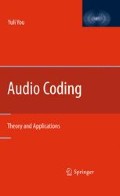Abstract
An audio signal often consists of quasistationary episodes, each including a number of tonal frequency components, which are frequently interrupted by dramatic transients. To achieve optimal energy compaction and thus coding gain, a filter bank with fine frequency resolution is necessary to resolve the tonal components or fine frequency structures in quasistationary episodes. But this filter bank is an ill fit for transients which often last for no more than a few samples, hence require fine time resolution for optimal energy compaction. Therefore, filter banks with both good time and frequency resolution are needed to effectively code audio signals.
Access this chapter
Tax calculation will be finalised at checkout
Purchases are for personal use only
Preview
Unable to display preview. Download preview PDF.
References
Davidson, G., Bosi, M.: AC-2: high quality audio coding for broadcasting and storage. 46th Annual Broadcasting Engineering Conference pp. 98–105 (1992)
Dolby Laboratories: Digital Audio Compression Standard A/52B. Advanced Television Systems Committee (ATSC) (2005)
Herre, J., Johnston, J.D.: Enhancing the performance of perceptual audio coders by using temporal noise shaping (TNS). 101st AES Convention (1996 Reprint #4384)
Johnston, J.D.: Transform coding of audio signals using perceptual noise criteria. IEEE Journal on Selected Areas in Communications 6(2), 314–323 (1988)
Johnston, J.D., Sinha, D., Dorward, S., Quackenbush, S.: AT&T perceptual audio coding (PAC). Collected Papers on Digital Audio Bit-Rate Reduction pp. 73–81 (1996)
MPEG: Coding of moving pictures and associated audio for digital storage media at up to about 1.5 Mbit/s – Part 3: Audio, vol. 11172-3. ISO/IEC (1993)
MPEG: Information technology: generic coding of moving pictures and associated audio information – Part 3: Audio, vol. 13818-3. ISO/IEC (1998)
MPEG: Coding of Audio-Visual Objects: Audio, vol. 14496-3. ISO/IEC (2005)
MPEG: Information technology: Generic coding of moving pictures and associated audio information Part 7: Advanced Audio Coding (AAC), vol. 13818-7. ISO/IEC (2006)
Painter, T., Spanias, A.: Perceptual coding of digital audio. Proceedings of the IEEE 88(4), 451–513 (2000)
Pinsky, M.A.: Introduction to Fourier Analysis and Wavelets. American Mathematical Society (2009)
Sinha, D., Johnston, J.D.: Audio compression at low bit rates using a signal adaptive switched filter bank. IEEE International Conference on Acoustics, Speech, and Signal Processing 2, 1053–1056 (1996)
Smyth, M.: White Paper: An Overview of the Coherent Acoustics Coding System. DTS, Agoura Hills (1999)
Stein, E., Shakarchi, R.: Fourier Analysis: An introduction. Princeton University Press, Princeton (2003)
Tsutsui, K.: ATRAC (adaptive transform acoustic coding) and ATRAC 2. In: V. Madisetti and D. Williams (eds.) The Digital Signal Processing Handbook, pp. 43.16–43.20. CRC, Boca Raton (1998)
Wikipedia: Windows Media Audio. http://en.wikipedia.org/wiki/Windows_Media_Audio (2007)
Xiph.org, F.: Vorbis I specification. Xiph.org Foundation (2004)
You, Y.L. et al.: Multichannel Digital Audio Coding Technology, vol. SJ/T11368-2006. Ministry of Information Industry, People’s Republic of China (2007)
Author information
Authors and Affiliations
Rights and permissions
Copyright information
© 2010 Springer US
About this chapter
Cite this chapter
You, Y. (2010). Transients. In: Audio Coding. Springer, Boston, MA. https://doi.org/10.1007/978-1-4419-1754-6_11
Download citation
DOI: https://doi.org/10.1007/978-1-4419-1754-6_11
Published:
Publisher Name: Springer, Boston, MA
Print ISBN: 978-1-4419-1753-9
Online ISBN: 978-1-4419-1754-6
eBook Packages: EngineeringEngineering (R0)

